Girona gold: How a diver discovered 400-year-old treasure
- Published
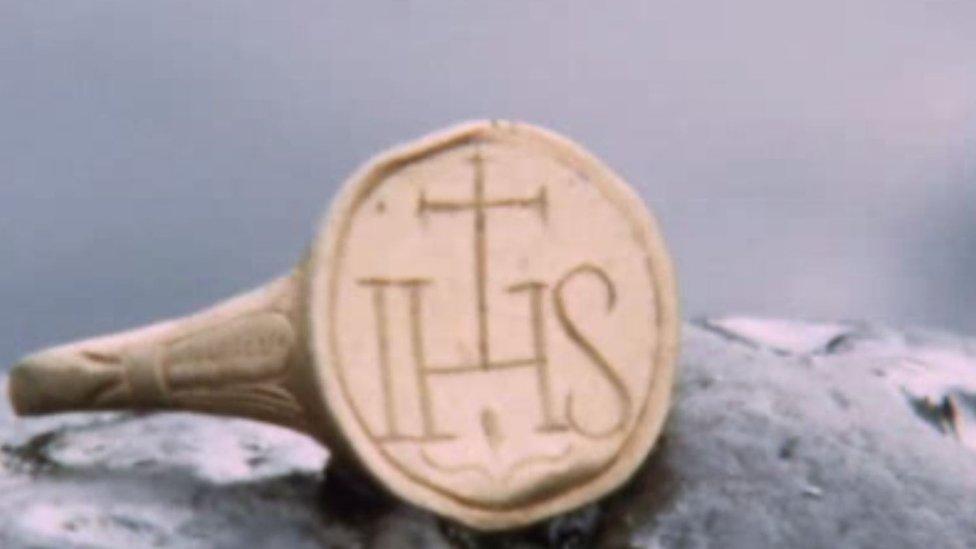
An artefact recovered from the Girona by Robert Sténuit and his crew 50 years ago
It was the discovery of a lifetime, an audacious Indiana Jones-style story of daring diving that uncovered a 400-year-old long-lost haul of Spanish treasure.
When Belgian Robert Sténuit discovered pieces of eight in the murky, freezing seabed off Northern Ireland's north coast 50 years ago he knew he'd finally found it.
Gold and artefacts deposited at the resting place of one of the most important ships in the Spanish Armada - the Girona.
In 1588, the ship sank beneath the harsh Atlantic waves after striking rocks at Lacada Point near Portballintrae, County Antrim.
Along with it went all but nine of the 1,300 people on board - along with a huge cache of Spanish treasure.
Now, the anniversary of Stenuit's startling discovery of the Girona gold has been commemorated in a series of events on Northern Ireland's north coast.
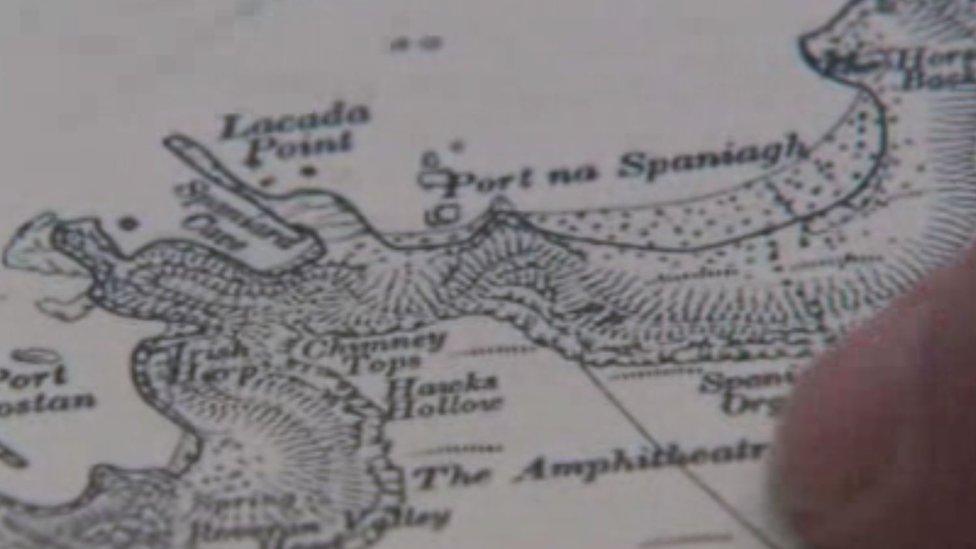
The Girona sank after striking a reef off Lacada Point
A wreath-laying ceremony took place from a Navy vessel near Lacada Point, the rocky outcrop that is believed to have been struck by the Girona.
On Friday evening, a service was held at St Cuthbert's Church near Dunluce Castle, where an estimated 260 Girona sailors were buried.
The events, organised by the Causeway Coast and Glens Council, not only commemorate the lives lost in the sinking, but also the cultural and historic impact of the Armada and its legacy.
The anniversary reflects not just on the gold and artefacts recovered by Sténuit, but also the stories of the Girona, long thought lost to the waves.
The Girona set sail in May 1588. A galleass ship - part galley, part galleon - it was meant to be one of Spain's decisive weapons in the war against England.
However, by the time it sank in October 1588, the ship carried far more men than it was equipped to carry after picking up surviving crew from other shipwrecks.
The nine survivors were helped by local chief Sorley Boy McDonnell.
McDonnell was also wary of attracting overt attention from crown forces who would take an interest in the Girona and its treasure - so he told them the ship had sunk at another point on the coast.
From then, the Girona and its secrets lay dormant for 400 years - until an intrepid Belgian launched a covert mission to uncover the lost Armada ship.
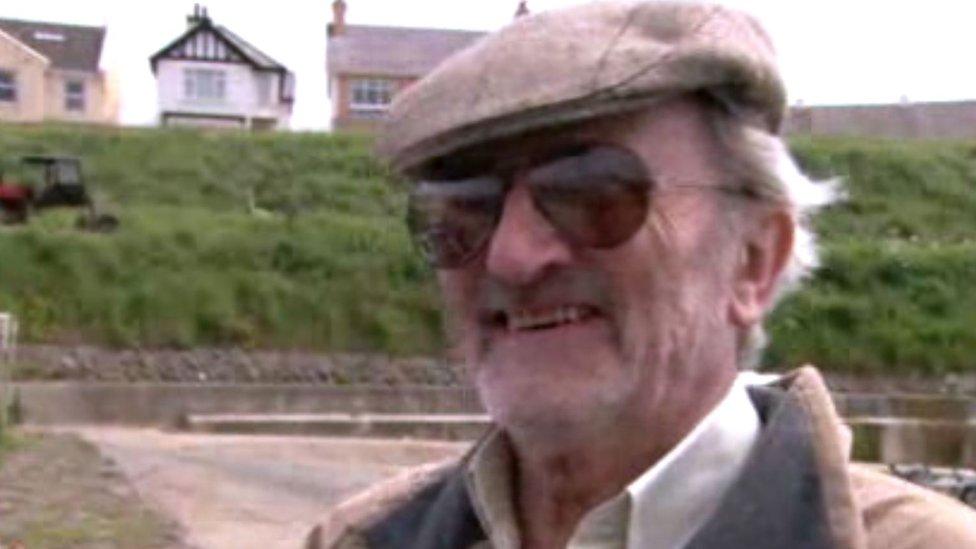
Robert Sténuit returned to Portballintrae for a 2008 documentary
Robert Sténuit was a trailblazing professional diver, who made one of the world's first prolonged deep dive, but was also a historian by trade - and he had a hunch that he knew where the Girona had sank.
Looking at 19th century maps, he noticed two markings - Spaniard Rock and Port na Spaniagh.
"When the first version of this map was made," he told a 2008 documentary, "the geographers came and asked people how is this place named and why. There was a very vivid memory of what had happened."
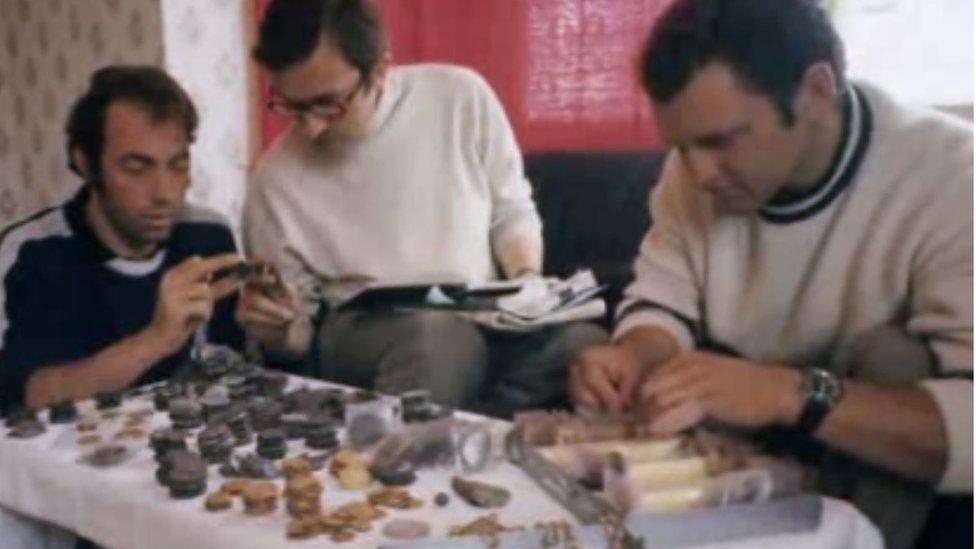
Robert Sténuit and his crew surveying their findings from the Girona
When the dive began in 1967, Sténuitt was accompanied by his associates, Mark Jasinski and his wife Annette.
After a week diving around Port na Spaniagh, they had located a bronze Armada cannon, an anchor and a gold escudo. They knew they were in the right place.
However, the crew maintained strict radio silence on their discovery - with no legal powers over the wreck site, they knew that they could potentially lose out.
They stashed their finds in an underwater cave and went to London to get financial backing for a more extensive dive of the seabed.
Sténhuit's expanded crew returned in April 1968 and, having registered an interest with the receiver of wrecks, he was confident that he had legal power over the site. Regardless, Sténuit kept things hush-hush.
"We told people we were filming the underwater eco-system around the Giants Causeway," he explained.
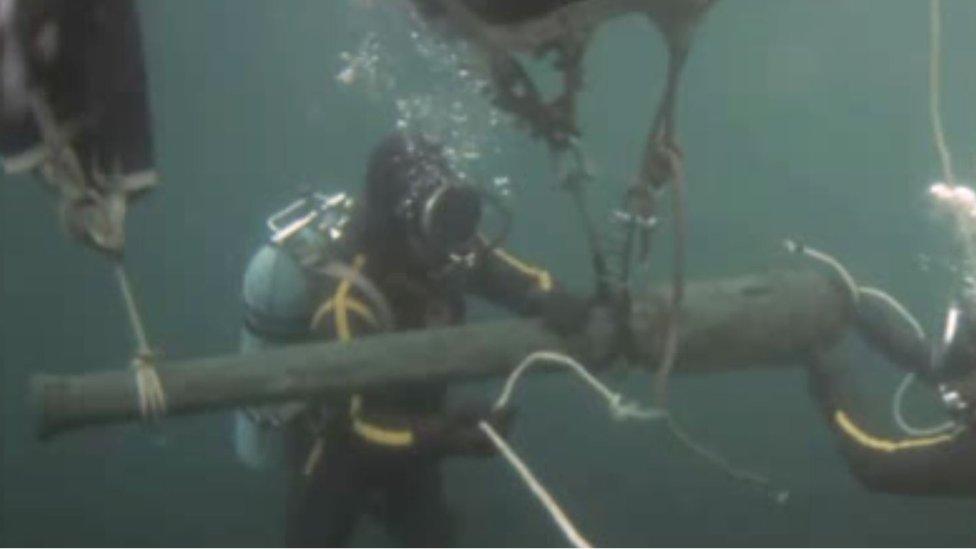
The crew raised an Armada cannon from the sea bed, a move that made their Girona secret public
However, the crew's decision to salvage a full cannon let the Armada secret out of the bag.
"Everyone could see what we were doing. There was pandemonium, there was big posters in the street," he said.
"The evening newspapers printed 'GOLD' like this across the front page, and everyone was there during the weekend. We were overwhelmed by tourists."
Soon, Sténhuit's crew were joined by a dozen or so divers from the Belfast Sub-Aqua Club.
The Belgian told the documentary: "I asked them if they were going to the site of the Girona, and none of them answered anything.
"I went to the skipper of an open boat who was there to take them somewhere and asked the same questions and he said 'no, we're going the other way, we're going west'.
"Then the boat went out of the harbour and went straight east to the Girona."

The bay where the Girona sank, as seen from the County Antrim coast
As Sténhuit described, they were "not coming in an inquisitive mind but an acquisitive mind" though Alan Wilson, from the club, said they simply thought they were "diving on a wreck".
"We thought there was a big boat there," he told the documentary, with a laugh.
In the end, headlines were made, but for slightly different reasons after Sténhuit confronted a diver underwater to stop him lifting a piece of lead from the wreck.
"It made me angry, yes," he said. "We were trying to reconstruct a puzzle and if you are missing a piece of the puzzle you cannot reconstruct it."
By 1969, Sténhuit and his crew felt that they had exhausted their dive efforts - but this was just the beginning of the story of who owned the Girona gold.
'Fulfilling'
Spain claimed that it should belong to them, while others argued that it should remain in Northern Ireland.
In the end, a court decided that no single owner could be found, so the artefacts would be sold.
They were valued at £132,000 and Sténhuit agreed a deal for it to stay in Northern Ireland and in the Ulster Museum, where the Girona gold remains a key part of the museum's exhibitions.
Sténhuit and Jesinski returned to Portballintrae to film the 2008 documentary, and recalled that while the endeavour was financially worthwhile, it was also the most fulfilling of their lives.
"I don't like the word profit, in that context," the Belgian said.
"Because it's not what we had in mind. Our time was compensated, and handsomely, in two ways. Because we had some of the best years of our lives and a little money to put butter in the spinach, as we say in France."